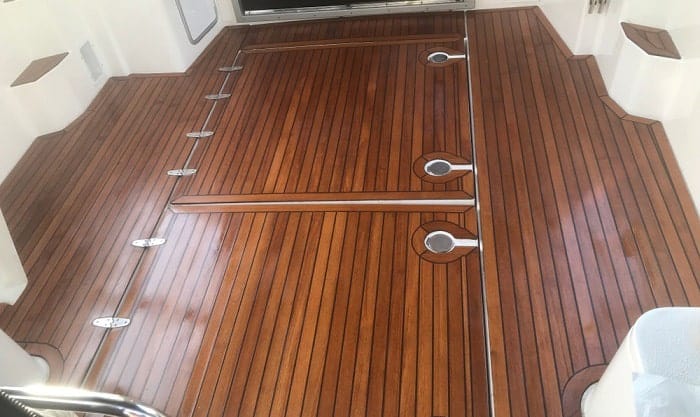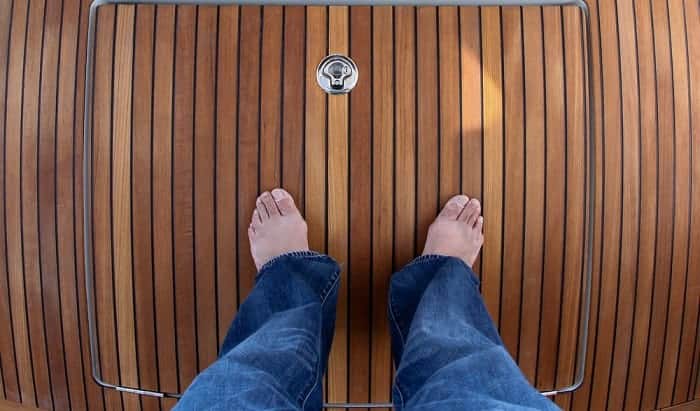Is your beloved boat’s floor showing signs of softening? That should be enough to sound the rot alert. A deck that’s operating in less than safe conditions is a big no and needs replacing ASAP.
So, how to replace boat floors? Below, I’ve shared the most common steps I follow in plenty of my restoration projects. These include removing every rotten component, building the floor parts, then doing the actual replacement.
Table of Contents
- Required Tools When Replacing The Floor In A Boat
- How to Replace Boat Floor
- Step 1. First and Foremost, Check the Transom
- Step 2. Build the Cradle
- Step 3. Take Everything Out of the Boat
- Step 4. Start Dismantling the Old Floor
- Step 5. Check for Other Parts that Have been Rotted
- Step 6. Start Measuring and Cutting the Plywood You Need
- Step 7. Lay Down the Cut Plywood
- Step 8. Cover the Floor with Fiberglass Mat
- Step 9. Reinstall the Components You Removed
- A Couple Of Tips Worth Keeping In Mind
- Conclusion
Required Tools When Replacing The Floor In A Boat
For the typical boat floor replacement of plywood, you’ll need:
- Circular saw
- Plywood
- Epoxy resin
- Mini tiller (if you need to remove damaged foam)
- Tape measure
- Corded or cordless drill
- Fiberglass resin and mat
Only order extra materials once you’ve confirmed that they’re needed for the restoration.
This list doesn’t account for any other task you may need to do to complete your boat’s restoration. This includes building the required cradle and the possibility of needing to replace the transom, too.
Before you start, I highly recommend you also document every step you do, so you’ll have a ready reference of what you’ve done so far. Replacing the floor usually takes up to 400 or more hours. It also won’t hurt to keep a note of measurements as well.
Obviously, every boat differs. Age and deck size serve as important factors in determining what steps you should take. I won’t be able to give you specific advice based on your boat’s type or make.
How to Replace Boat Floor
Step 1. First and Foremost, Check the Transom
Many boat owners who have to replace a boat floor often need to restore the transmon as well. Check for signs of rot. Always keep in mind that decay in boats starts from the bottom up.
You can do a quick test of the transom’s stability by stepping on top of it and putting a little weight on it. Any sign of flex is bad and almost always means there’s decay present already.
Step 2. Build the Cradle
I’ve found that it’s always best to build a dedicated cradle to support the boat’s hull instead of doing the replacement in the trailer to prevent damaging the latter.
Good if you already have one or an alternative available on hand.
Step 3. Take Everything Out of the Boat
You’re replacing the floor, so this is inevitable. Anything that’s attached to the previous deck will have to be removed. This includes the consoles and seats. You most likely have to deal with wirings when removing them.
Get the motor out as well. Whether it’s an outboard or I/O motor, you’ll also have to learn how to remove it, too.
Step 4. Start Dismantling the Old Floor
Determine the ideal depth for the circular saw before cutting the floor (unless you want to damage the hull!). ⅝” is a common figure in most projects I’ve handled.
I always prefer to have a guide once I’m installing the new deck so I make sure to maintain the former floor’s dimensions when removing it. The best practice for me is to leave at least 3 inches of the previous floor up to the boat’s edge.
Doing this also ensures I don’t end up damaging the side of the boat when taking out the floor. You can even use it as a support for the new one.
Step 5. Check for Other Parts that Have been Rotted
Once you get the old floor out, it’s now time to do a little diagnosing. Check the condition of the stringers and the foam. Are the stringers and bulkheads all black? That’s almost always a tell-tale sign that they’re rotted.
Is the foam still intact? If yes, then you’ll probably only need to replace most of the wood. If not, then you’ll need to take it out.
I have a mini tiller that is perfect for taking out the most damaged foams in no time. With its design, I can scrape out most foam easily.
Step 6. Start Measuring and Cutting the Plywood You Need
Once you have removed all the parts that have been damaged or decayed, that’s the only time for you to start replacing a boat floor.
Begin laying down the plywood you’ve bought while using portions of the original floor as a gauge of how much you need to cut. You can use a tape measure to double-check before cutting.
Step 7. Lay Down the Cut Plywood
Apply epoxy on the areas of the new plywood that will be included to provide water protection.
Once it has dried, that’s the only time for you to use the drill to mark out the appropriate areas of the plywood that you need to screw in place. It’s better to have holes as a guide when laying down the cut plywood.
Step 8. Cover the Floor with Fiberglass Mat
Assuming you’re not adding a layer of foam anymore, lay down the fiberglass matt on the plywood you place. Use the resin to seal it in place.
Once it has dried, you can choose to sand the edges to smoothen them. Otherwise, you can now proceed to screw the mat in place. You’re pretty much done once with the replacement once you complete this.
Step 9. Reinstall the Components You Removed
Once that’s out of the way, you can now replace the parts you took out earlier. If you placed a new carpet, you need to be mindful of wirings and screw holes intended for the seats, etc.
A Couple Of Tips Worth Keeping In Mind
- When you put a new floor in a boat, think of factors like durability and marine-friendliness of the plywood.
- Removing the boat’s cap makes it easier for you to access the entire floor area. I don’t do it in all my replacement jobs.
- Take note that carpet tends to retain moisture, which is often a terrible idea if you want to keep rot away for good.
- You can decide to add waterproofing to your bulkheads and stringers from products like RedGard. However, in most cases, I’ve found this to be a bit of an overkill already since I’m also using marine-friendly wood and epoxy.
Conclusion
Did you like my guide on how to replace boat floor? I did my best to provide a comprehensive and detailed outline of what works for me. Ultimately, I won’t be surprised if you need to make adjustments based on your boat’s exact requirements. Also, check out more boat maintenance tutorials here if you like!
Got any knowledge or feedback on boat floor repair to share? I’d be happy to know about them in the comments section!

“I am James Harvey – founder of Boating Basics Online. It is established with the drive to help out first-time boaters, which are those desiring to explore their way through the water. So if you are new to boating, start from here with me. “



